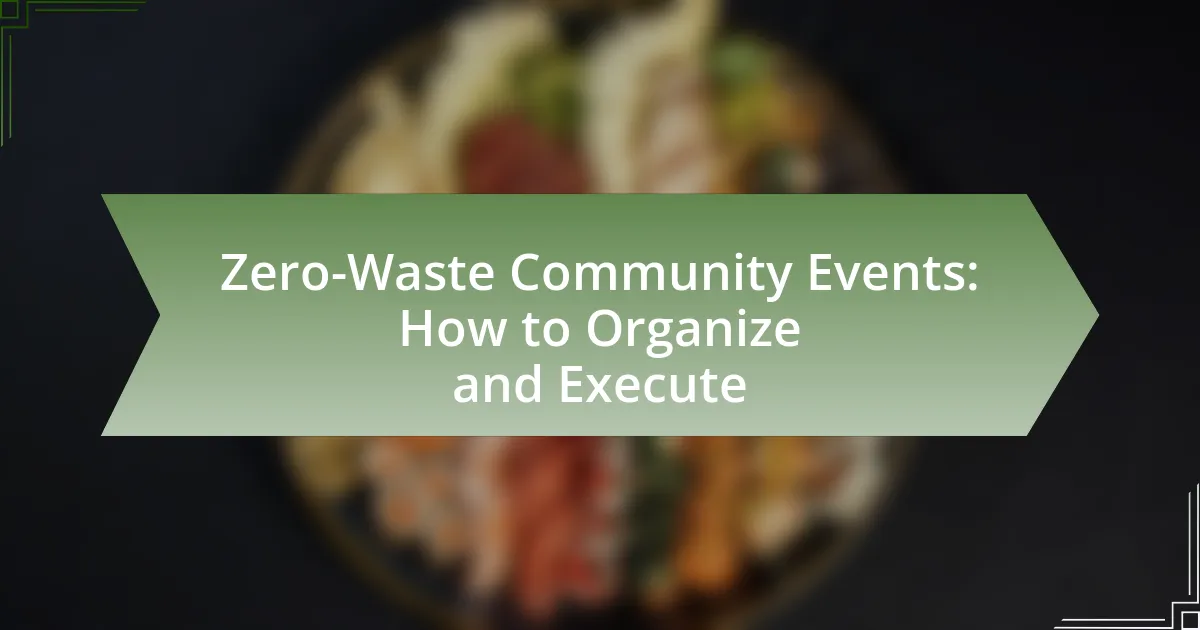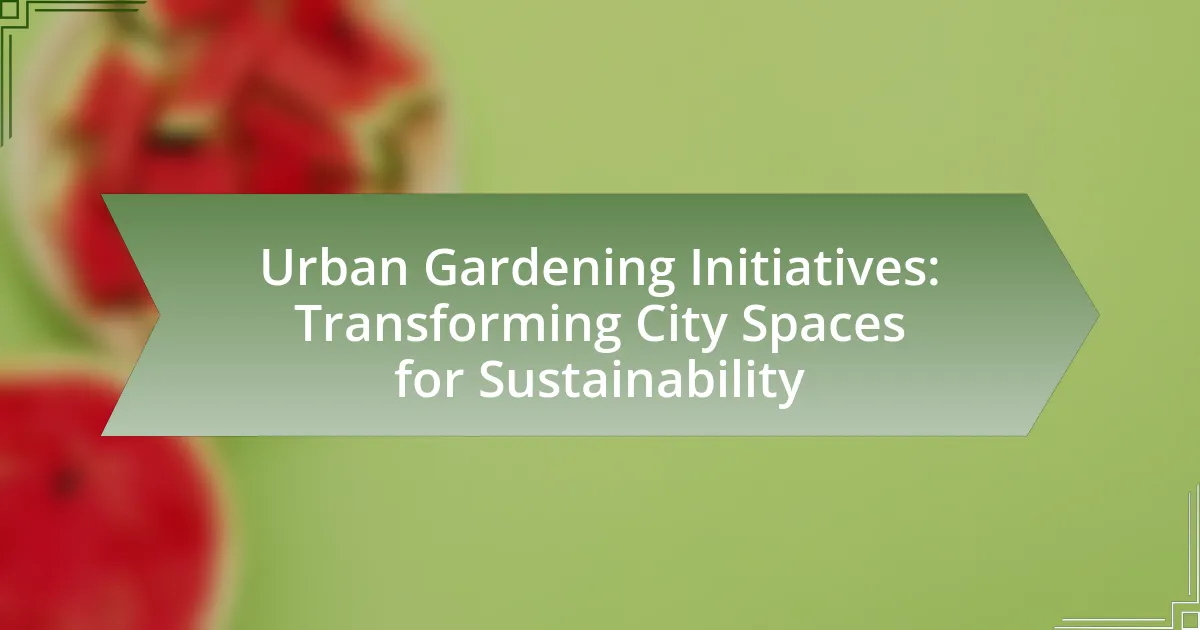Eco-friendly packaging solutions for community vendors encompass biodegradable materials, compostable packaging, and reusable containers, all aimed at reducing environmental impact and appealing to sustainability-conscious consumers. The article explores the differences between eco-friendly and traditional packaging, detailing commonly used materials such as recycled paper and plant-based plastics, and their positive effects on the environment. It also addresses the importance of these solutions for community vendors, the challenges they face in adoption, and strategies for effective implementation. Additionally, the article highlights future trends in sustainable packaging and best practices for vendors to enhance their brand image while minimizing waste.
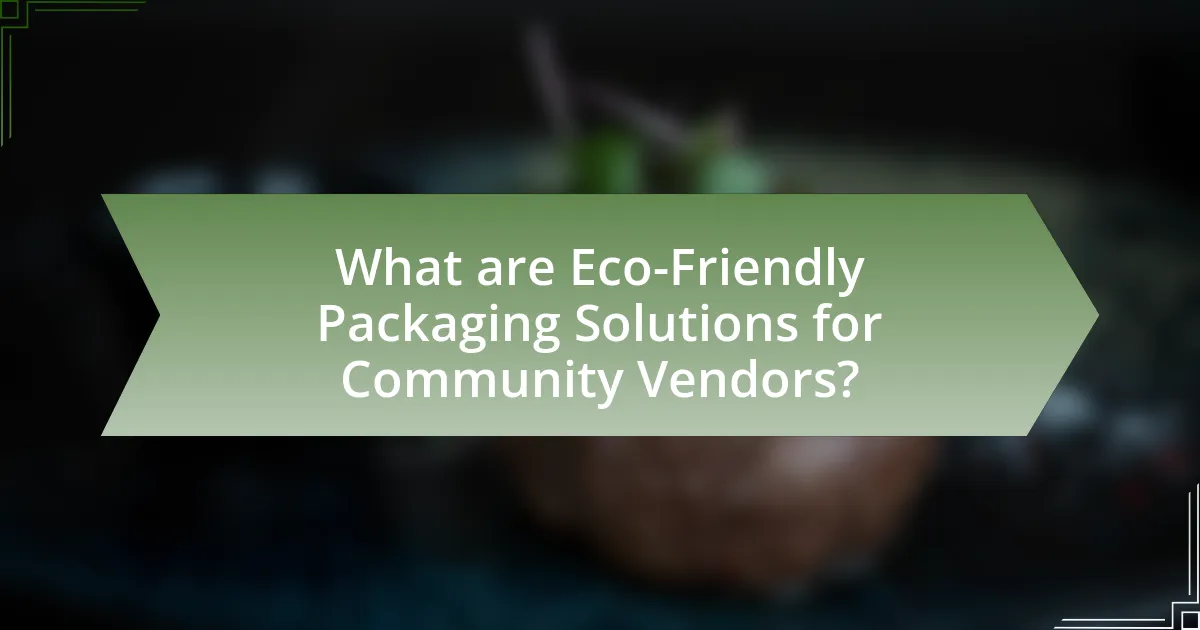
What are Eco-Friendly Packaging Solutions for Community Vendors?
Eco-friendly packaging solutions for community vendors include biodegradable materials, compostable packaging, and reusable containers. Biodegradable materials, such as plant-based plastics, break down naturally and reduce landfill waste. Compostable packaging, made from materials like cornstarch or sugarcane, can decompose in composting facilities, enriching the soil. Reusable containers, such as glass jars or metal tins, encourage customers to return for refills, minimizing single-use waste. These solutions not only align with sustainability goals but also appeal to environmentally conscious consumers, enhancing brand loyalty and community support.
How do Eco-Friendly Packaging Solutions differ from traditional packaging?
Eco-friendly packaging solutions differ from traditional packaging primarily in their materials and environmental impact. Eco-friendly packaging is made from sustainable, biodegradable, or recyclable materials, such as plant-based plastics or recycled paper, which reduce waste and pollution. In contrast, traditional packaging often relies on single-use plastics and non-biodegradable materials, contributing significantly to landfill waste and environmental degradation. According to a study by Smithers Pira, the global market for sustainable packaging is expected to reach $500 billion by 2024, highlighting a growing shift towards environmentally responsible practices.
What materials are commonly used in eco-friendly packaging?
Common materials used in eco-friendly packaging include recycled paper, biodegradable plastics, plant-based materials, and glass. Recycled paper is sourced from post-consumer waste, reducing the need for virgin materials and minimizing environmental impact. Biodegradable plastics, often made from cornstarch or other renewable resources, break down more easily in the environment compared to traditional plastics. Plant-based materials, such as bamboo or sugarcane, are sustainable alternatives that offer durability while being compostable. Glass is recyclable and can be reused multiple times without losing quality, making it an eco-friendly choice. These materials collectively contribute to reducing waste and promoting sustainability in packaging solutions.
How do these materials impact the environment?
Eco-friendly packaging materials significantly reduce environmental impact by minimizing waste and pollution. These materials, such as biodegradable plastics and recycled paper, decompose more easily than traditional plastics, leading to less landfill accumulation and lower greenhouse gas emissions. For instance, biodegradable plastics can break down in composting conditions within a few months, compared to conventional plastics that can take hundreds of years to decompose. Additionally, using recycled materials decreases the demand for virgin resources, conserving energy and reducing deforestation. Studies show that using recycled paper can save up to 60% of the energy required to produce new paper, thus lowering carbon footprints.
Why are Eco-Friendly Packaging Solutions important for community vendors?
Eco-friendly packaging solutions are important for community vendors because they enhance sustainability and appeal to environmentally conscious consumers. By utilizing biodegradable or recyclable materials, community vendors can reduce their environmental footprint, which is increasingly valued by customers; a 2021 survey indicated that 72% of consumers prefer brands that use sustainable packaging. Additionally, eco-friendly packaging can differentiate vendors in a competitive market, fostering customer loyalty and potentially increasing sales.
What role does sustainability play in community markets?
Sustainability plays a crucial role in community markets by promoting environmentally responsible practices that benefit local economies and ecosystems. Community markets often prioritize sustainable sourcing, which encourages vendors to use local, organic, and ethically produced goods, thereby reducing carbon footprints associated with transportation and industrial agriculture. For instance, a study by the USDA found that local food systems can reduce greenhouse gas emissions by up to 25% compared to conventional food distribution methods. Additionally, sustainable practices in community markets, such as the use of eco-friendly packaging, help minimize waste and pollution, fostering a culture of environmental stewardship among consumers and vendors alike.
How can eco-friendly packaging enhance a vendor’s brand image?
Eco-friendly packaging can enhance a vendor’s brand image by demonstrating a commitment to sustainability and environmental responsibility. This commitment resonates with consumers, as studies show that 72% of consumers are willing to pay more for products with sustainable packaging. By using eco-friendly materials, vendors can differentiate themselves in a competitive market, attract environmentally conscious customers, and foster brand loyalty. Additionally, positive brand perception is reinforced through social media and word-of-mouth, as consumers often share their support for brands that prioritize eco-friendly practices.
What challenges do community vendors face when adopting eco-friendly packaging?
Community vendors face several challenges when adopting eco-friendly packaging, primarily including higher costs, limited availability, and consumer awareness. The higher costs associated with eco-friendly materials often deter vendors from making the switch, as these materials can be significantly more expensive than traditional packaging options. Limited availability of sustainable packaging options in local markets further complicates the transition, making it difficult for vendors to source suitable materials. Additionally, consumer awareness and demand for eco-friendly packaging can be low, leading to concerns about whether the investment will yield sufficient returns. These challenges are supported by research indicating that cost and supply chain issues are among the top barriers to adopting sustainable practices in small businesses.
What are the cost implications of switching to eco-friendly options?
Switching to eco-friendly options typically incurs higher initial costs compared to conventional materials. For instance, biodegradable packaging can be 10-30% more expensive than traditional plastic. However, long-term savings may arise from reduced waste disposal fees and potential tax incentives for sustainable practices. A study by the Ellen MacArthur Foundation indicates that transitioning to circular economy models can lead to cost reductions of up to 50% in material costs over time. Therefore, while the upfront investment is significant, the overall financial impact can be favorable in the long run.
How can vendors overcome supply chain issues related to eco-friendly packaging?
Vendors can overcome supply chain issues related to eco-friendly packaging by diversifying their supplier base and investing in local sourcing. Diversifying suppliers reduces dependency on a single source, mitigating risks associated with disruptions. For instance, a study by the World Economic Forum highlights that companies with multiple suppliers are 30% more resilient to supply chain shocks. Additionally, local sourcing minimizes transportation costs and lead times, enhancing supply chain efficiency. By adopting these strategies, vendors can ensure a more reliable and sustainable supply of eco-friendly packaging materials.
How can community vendors effectively implement Eco-Friendly Packaging Solutions?
Community vendors can effectively implement eco-friendly packaging solutions by selecting biodegradable materials, utilizing minimal packaging designs, and encouraging customer participation in recycling programs. Biodegradable materials, such as plant-based plastics or recycled paper, decompose naturally, reducing landfill waste. Minimal packaging designs not only lower material usage but also decrease transportation emissions, as lighter packages require less energy to transport. Additionally, engaging customers in recycling initiatives fosters a culture of sustainability and increases the likelihood of proper disposal. According to a 2021 study by the Ellen MacArthur Foundation, transitioning to biodegradable packaging can reduce plastic pollution by up to 80%, demonstrating the significant impact of these strategies.
What steps should vendors take to transition to eco-friendly packaging?
Vendors should conduct a comprehensive assessment of their current packaging materials and processes to transition to eco-friendly packaging. This involves identifying non-biodegradable materials and evaluating alternatives such as biodegradable, compostable, or recyclable options. Research indicates that switching to sustainable packaging can reduce carbon footprints significantly; for instance, a study by the Ellen MacArthur Foundation found that transitioning to circular packaging could reduce greenhouse gas emissions by 45% by 2030. Additionally, vendors should engage with suppliers who specialize in eco-friendly materials, ensuring that their supply chain aligns with sustainability goals. Implementing consumer education initiatives about the benefits of eco-friendly packaging can also enhance customer engagement and support for the transition.
How can vendors educate their customers about eco-friendly packaging benefits?
Vendors can educate their customers about eco-friendly packaging benefits by providing clear, accessible information through various channels. For instance, they can create informative brochures that outline the environmental advantages of using sustainable materials, such as reduced carbon footprints and decreased landfill waste. Research indicates that consumers are more likely to support brands that demonstrate environmental responsibility; a study by Nielsen found that 66% of global consumers are willing to pay more for sustainable brands. Additionally, vendors can host workshops or webinars to engage customers directly, allowing for interactive discussions about the impact of packaging choices on the environment. Social media platforms can also be utilized to share educational content, such as infographics and videos, that highlight the benefits of eco-friendly packaging. By employing these strategies, vendors can effectively raise awareness and foster a more environmentally conscious consumer base.
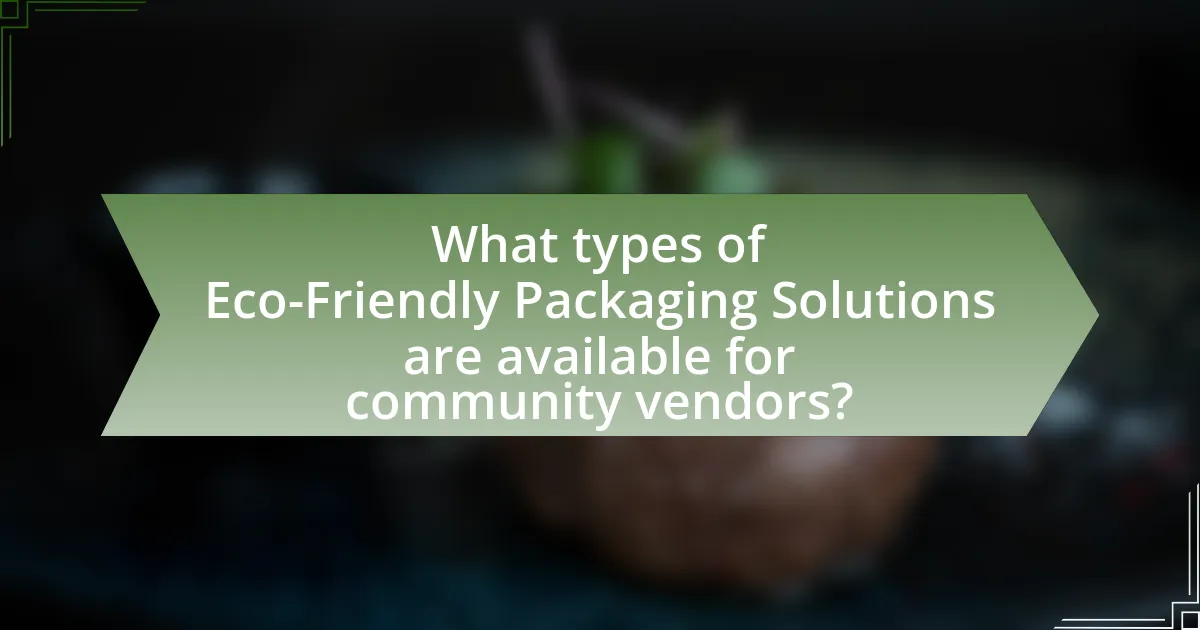
What types of Eco-Friendly Packaging Solutions are available for community vendors?
Community vendors have access to several types of eco-friendly packaging solutions, including biodegradable bags, compostable containers, recycled paper products, and reusable packaging options. Biodegradable bags break down naturally over time, reducing landfill waste. Compostable containers are designed to decompose in composting environments, contributing to soil health. Recycled paper products utilize post-consumer waste, minimizing the need for virgin materials. Reusable packaging options, such as glass jars or cloth bags, encourage sustainability by reducing single-use items. These solutions not only help in reducing environmental impact but also align with consumer preferences for sustainable practices.
What are the most popular types of eco-friendly packaging materials?
The most popular types of eco-friendly packaging materials include biodegradable plastics, recycled paper, glass, and plant-based materials. Biodegradable plastics, made from renewable resources, decompose more quickly than traditional plastics, reducing environmental impact. Recycled paper is widely used due to its ability to be repurposed multiple times, thus conserving trees and energy. Glass is recyclable indefinitely without loss of quality, making it a sustainable choice for packaging. Plant-based materials, such as cornstarch or sugarcane, offer alternatives to petroleum-based products and are compostable. These materials collectively contribute to reducing waste and promoting sustainability in packaging.
How do biodegradable materials compare to recyclable options?
Biodegradable materials decompose naturally over time, while recyclable options can be processed and reused indefinitely. Biodegradable materials, such as plant-based plastics, break down into natural substances through microbial action, typically within a few months to a few years, depending on environmental conditions. In contrast, recyclable materials, like paper and certain plastics, require specific facilities to be processed and can be recycled multiple times, reducing the need for new raw materials. According to the Environmental Protection Agency, recycling can save significant energy and resources, whereas biodegradable materials may not always be composted properly, leading to potential environmental issues if disposed of incorrectly.
What are the benefits of using compostable packaging?
Compostable packaging offers significant environmental benefits by reducing waste and promoting sustainability. Unlike traditional plastics, compostable materials break down into natural substances, enriching the soil and minimizing landfill contributions. According to the Environmental Protection Agency, composting can divert approximately 30% of waste from landfills, thereby decreasing greenhouse gas emissions. Additionally, compostable packaging supports a circular economy by returning nutrients to the earth, fostering healthier ecosystems. This aligns with growing consumer demand for eco-friendly products, enhancing brand reputation and customer loyalty for community vendors.
How can vendors choose the right eco-friendly packaging for their products?
Vendors can choose the right eco-friendly packaging for their products by assessing materials based on sustainability, functionality, and consumer preferences. Sustainable materials include biodegradable plastics, recycled paper, and plant-based options, which reduce environmental impact. Functionality involves ensuring the packaging protects the product during transport and storage while being easy to use for consumers. Additionally, understanding consumer preferences for eco-friendly options can guide vendors in selecting packaging that resonates with their target market. Research indicates that 72% of consumers are willing to pay more for sustainable packaging, highlighting the importance of aligning packaging choices with consumer values.
What factors should be considered when selecting packaging materials?
When selecting packaging materials, factors such as material sustainability, cost-effectiveness, product protection, and consumer appeal must be considered. Sustainable materials, like biodegradable plastics or recycled paper, reduce environmental impact and align with eco-friendly practices. Cost-effectiveness ensures that the packaging fits within budget constraints while maintaining quality. Product protection is crucial to prevent damage during transit and storage, which can affect customer satisfaction. Lastly, consumer appeal influences purchasing decisions; attractive packaging can enhance brand perception and encourage sales. These factors collectively guide vendors in making informed choices that support both their business goals and environmental responsibility.
How can vendors assess the environmental impact of their packaging choices?
Vendors can assess the environmental impact of their packaging choices by conducting life cycle assessments (LCAs) that evaluate the environmental effects from raw material extraction to disposal. LCAs provide quantitative data on factors such as carbon footprint, energy consumption, and waste generation associated with different packaging materials. For instance, a study published in the Journal of Cleaner Production found that switching from plastic to biodegradable materials can reduce greenhouse gas emissions by up to 50%. By utilizing LCAs and similar analytical tools, vendors can make informed decisions that align with sustainability goals and minimize their ecological footprint.
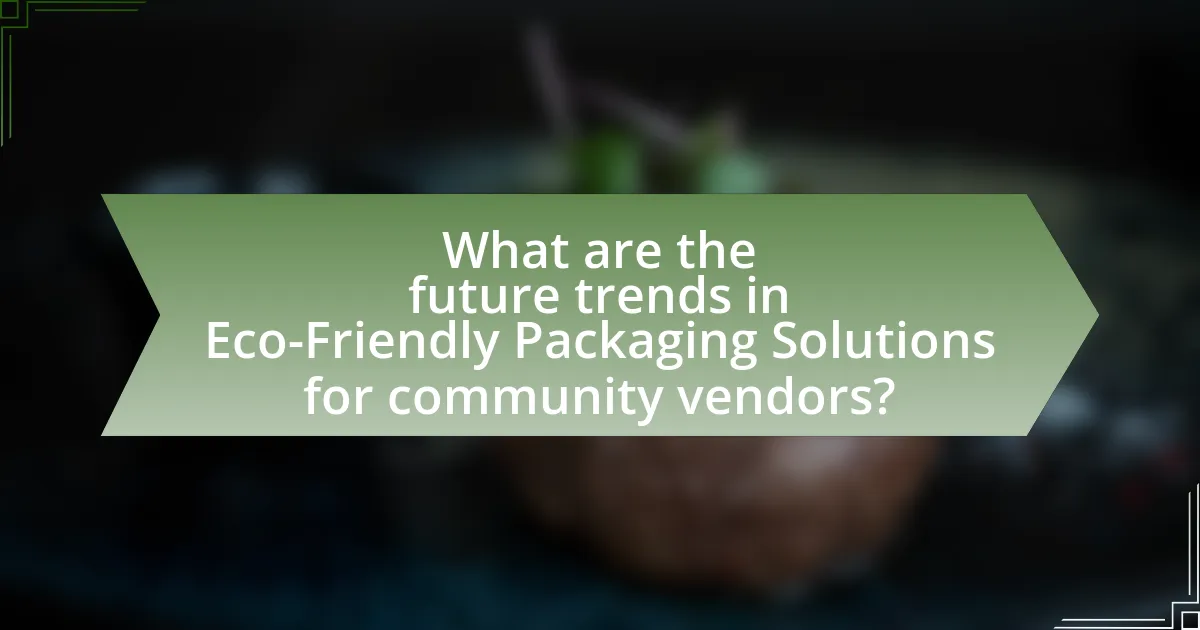
What are the future trends in Eco-Friendly Packaging Solutions for community vendors?
Future trends in eco-friendly packaging solutions for community vendors include increased use of biodegradable materials, innovative reusable packaging systems, and the adoption of minimalistic designs to reduce waste. Biodegradable materials, such as plant-based plastics and compostable paper, are gaining traction as they break down naturally, minimizing environmental impact. Innovative reusable packaging systems, like deposit return schemes, encourage customers to return containers for reuse, thus reducing single-use packaging. Additionally, minimalistic designs focus on reducing excess packaging, which aligns with consumer demand for sustainability. According to a report by Smithers Pira, the global market for sustainable packaging is projected to reach $500 billion by 2027, indicating a significant shift towards eco-friendly solutions in the packaging industry.
How is technology influencing eco-friendly packaging innovations?
Technology is significantly influencing eco-friendly packaging innovations by enabling the development of sustainable materials and efficient production processes. Advanced technologies such as bioplastics derived from renewable resources, like cornstarch and sugarcane, are being utilized to create packaging that is both biodegradable and compostable. For instance, a study published in the journal “Nature” highlights that bioplastics can reduce carbon emissions by up to 80% compared to traditional plastics. Additionally, innovations in digital printing and smart packaging technologies allow for reduced waste and enhanced recyclability, as seen in companies adopting water-based inks and recyclable substrates. These technological advancements not only improve the environmental footprint of packaging but also meet consumer demand for sustainable products.
What role do smart packaging solutions play in sustainability?
Smart packaging solutions significantly enhance sustainability by reducing waste and improving resource efficiency. These solutions utilize technologies such as RFID, QR codes, and sensors to provide real-time data on product conditions, enabling better inventory management and reducing spoilage. For instance, a study by the Ellen MacArthur Foundation highlights that smart packaging can lead to a 20% reduction in food waste by ensuring products are consumed before expiration. Additionally, smart packaging can facilitate recycling by providing clear information on material composition, thus promoting proper disposal and reducing landfill contributions.
How can community vendors stay updated on packaging trends?
Community vendors can stay updated on packaging trends by subscribing to industry newsletters, attending trade shows, and participating in online forums focused on sustainable packaging. These resources provide timely information on innovations and best practices in eco-friendly packaging. For instance, the Sustainable Packaging Coalition regularly publishes reports and updates that highlight emerging trends and technologies in the packaging sector, which can be invaluable for vendors looking to enhance their packaging strategies.
What best practices should community vendors follow for eco-friendly packaging?
Community vendors should prioritize using biodegradable, compostable, or recyclable materials for eco-friendly packaging. These materials reduce environmental impact by breaking down naturally or being repurposed, thus minimizing landfill waste. For instance, according to a study by the Ellen MacArthur Foundation, switching to biodegradable packaging can significantly decrease plastic pollution. Additionally, vendors should aim to minimize packaging size and use minimalistic designs to reduce material consumption. Implementing reusable packaging systems, such as encouraging customers to bring their own containers, can further enhance sustainability. By adopting these practices, community vendors contribute to a circular economy and promote environmental responsibility.
How can vendors effectively communicate their eco-friendly efforts to customers?
Vendors can effectively communicate their eco-friendly efforts to customers by utilizing transparent messaging that highlights specific sustainable practices. For instance, vendors should detail the materials used in their packaging, such as biodegradable or recycled components, and explain the environmental benefits of these choices. Research indicates that 73% of consumers are willing to pay more for sustainable products, demonstrating that clear communication about eco-friendly initiatives can enhance customer loyalty and trust. Additionally, vendors can leverage social media platforms to share stories and visuals of their sustainable practices, further engaging customers and reinforcing their commitment to environmental responsibility.
What are some common mistakes to avoid when implementing eco-friendly packaging?
Common mistakes to avoid when implementing eco-friendly packaging include selecting materials that are not truly biodegradable or recyclable, which can mislead consumers and undermine sustainability efforts. Many vendors mistakenly assume that all biodegradable materials break down in any environment, while in reality, some require specific conditions to decompose effectively. Additionally, failing to educate consumers about the proper disposal methods for eco-friendly packaging can lead to contamination in recycling streams. Another mistake is overlooking the supply chain; sourcing eco-friendly materials from suppliers who do not adhere to sustainable practices can negate the benefits of using green packaging. Lastly, neglecting to consider the overall lifecycle of the packaging, including production and transportation emissions, can result in a higher environmental impact than anticipated.



